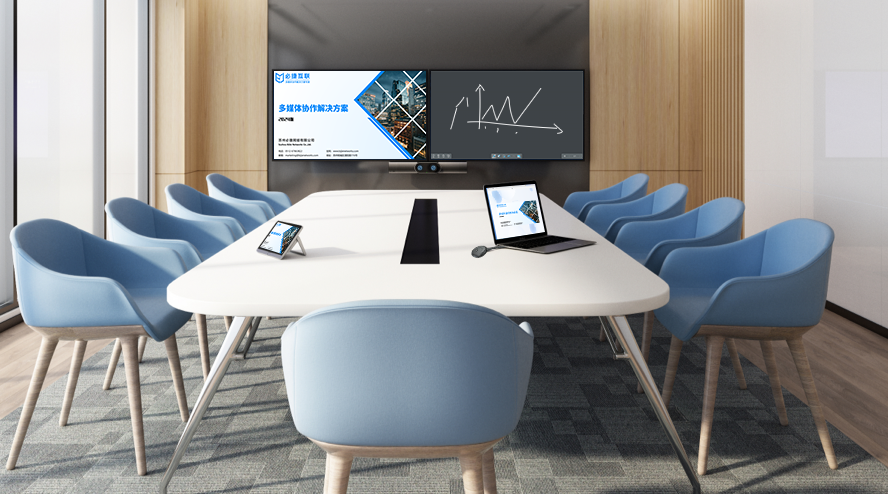WiDi: A Wireless Screen Mirroring Solution for Windows
The WiDi solution is built on Windows’ native wireless display technology and developed specifically for Windows devices. It allows for a seamless connection between a computer and a large screen without the need for third-party software. With simple operation and reliable transmission, it’s perfect for office meetings, classes, and design discussions, making screen mirroring more efficient and convenient for Windows users.
Universal Compatibility, Zero Connection Barrier
It covers laptops, desktops, and 2-in-1 devices running Windows 8.1 and above, and it’s compatible with mainstream brands like Lenovo, HP, Dell, and ASUS. Both new and old models are natively compatible with WiDi, from an older office laptop to a new high-performance gaming laptop. The connection process is incredibly simple: open the Windows “Start” menu, click the “Project” option, find the receiver, and select “Connect.” Pairing is completed in under 2 seconds, with no need to install drivers or plugins. Anyone can learn how to use it right away, with a compatibility rate of over 95%.
Clear and Stable Transmission, Precise Detail Display
It supports 1080P Full HD mirroring. When you mirror an engineering drawing, the slight changes in line thickness and the tiny differences in annotated text are clearly visible. When you mirror a financial report, the complex data charts and numbers with two decimal places are sharp and clear. When paired with a device with an Intel Iris Xe or higher integrated graphics card, it can achieve 4K Ultra HD transmission, meeting the strict quality requirements of professional scenarios like design and post-production. It uses a dedicated wireless transmission protocol to effectively avoid Wi-Fi signal interference, with a transmission latency as low as 20ms and an audio-video synchronization error of less than 8ms. When playing a dynamic presentation or a product demo video, there’s no ghosting or lagging. Operations like turning pages and zooming in are smooth and responsive, and the experience is comparable to a wired connection.
Scenario-Specific Functions for Diverse Needs
Office Meetings: More Efficient Collaboration
- Multi-Device Relay Mirroring: In a multi-person meeting, multiple Windows computers can take turns connecting to the large screen. When one disconnects, the next one can quickly connect through “recent connections,” so proposal comparisons and presentations are not interrupted, and the meeting flows more smoothly.
- Extended Screen Collaboration: You can set the large screen as a “secondary screen” for your computer. You can edit a proposal on the main screen while simultaneously displaying reference materials or data charts on the secondary screen, boosting multitasking efficiency by 40%.
- Real-Time Annotation: You can use a computer mouse or stylus to annotate key points and add edits to the mirrored content. The annotations are synchronized to the large screen in real time and can be exported as a PDF with one click at the end of the meeting to be used as an attachment to the meeting minutes.
Classroom Teaching: More Lively Interaction
- Mobile Lessons: A teacher can use a Windows laptop to mirror courseware and use keyboard shortcuts to turn pages even from the back of the classroom. For complex formulas, they can use a digital writing pad to annotate in real time on the computer, and the large screen will display the markings in sync, making them clearer for students to see.
- Dual-Screen Comparative Teaching: The main screen can display an explanation of a concept, while a secondary screen displays a student’s homework or problem-solving process. This dual-screen comparison helps students quickly understand common mistakes.
- Offline Direct Connection: In an environment with no network, it supports a direct device connection for mirroring. For outdoor studies or lab lessons, you can mirror educational materials from your computer to a mobile large screen without relying on Wi-Fi.
Design Discussions: Bringing Ideas to Life
- Real-Time Edits: When a designer is running software like PS or CAD on a Windows computer, the operation is mirrored to the large screen in real time. The team can then gather around the large screen to discuss color schemes and modeling details, and any edits made on the computer are visible in sync, with no need to repeatedly export images and copy them to a USB drive.
- Multi-Version Comparison: You can mirror different versions of the same design to a large screen in a split-screen view, making it easy to see the differences at a glance and refine ideas more efficiently.
Smart Management + Security, for a Hassle-Free Experience
- Precise Access Control: An administrator can set up a “device whitelist” from a backend, allowing only designated Windows devices to mirror content, which prevents interference from unauthorized devices. For temporary visitors, a one-time authorization code can be generated, and the permission automatically expires after use, protecting content privacy.
- Smart Connection Memory: The receiver automatically remembers the last 5 frequently used Windows devices. The next time a device is on and on the same network, a pop-up will automatically remind you to connect, so you don’t have to search again.
- Remote Management: An administrator can remotely view the operational status of the mirroring devices (including the number of connections, signal strength, and firmware version). It supports remote on/off and online firmware upgrades, so no on-site maintenance is required, which reduces management costs.
Installation and deployment are simple. You just need to connect the WiDi receiver to the large screen with an HDMI cable and to the network to use it, with no need to modify your existing meeting or teaching system. Whether for an enterprise, a school, or a design team, this screen mirroring solution for Windows devices can precisely meet your needs, making content display more efficient and collaboration smoother.